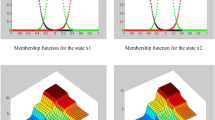Abstract
The stochastic Mamdani and Takagi–Sugeno fuzzy systems are firstly unified in a random environment, and the resulting stochastic hybrid fuzzy system is established according to some stochastic parameters. Secondly, A canonical representation of the stochastic process with orthogonal increments is presented by the properties of the Lebesgue–Stieltjes measure and stochastic integral, the approximation of the stochastic hybrid fuzzy system in the mean square sense is proved. Finally, an implementation process of this system is described through a simulation example, and the surface figure of the covariance function shows that the stochastic hybrid fuzzy system has excellent approximation capability.





Similar content being viewed by others
References
Lui PY, Li HX (2000) Approximation of generalized fuzzy system to integrable function. Sci China Ser E 43(6):618–628
Liu PY, Li HX (2001) Analyses for Lp (μ)-norm approximation capability of the generalized Mamdani fuzzy systems. Inf Sci 138(2):195–210
Liu PY, Li HX (2000) Equivalence of generalized Takagi–Sugeno fuzzy system and its hierarchical systems. J Beijing Norm Univ (Nat Sci) 36(5):612–618
Zeng K, Zhang NR, Xu WL (2001) Sufficient condition for linear T–S fuzzy systems universal approximation. Acta Automatica Sinica 27(5):606–612
Wang LX (1999) Universal approximation by hierarchical fuzzy systems. Fuzzy Sets Syst 93(2):223–230
Zeng XJ, Keane AJ (2005) Approximation capabilities of hierarchical fuzzy systems. IEEE Trans Fuzzy Syst 13(5):659–672
Ricardo J, Campello GB, Wagner C (2006) Hierarchical fuzzy relational models: linguistic interpretation and universal approximation. IEEE Trans Fuzzy Syst 14(3):446–453
Zhang YZ, Li HX (2006) Generalized hierarchical Mamdani fuzzy systems and their universal approximation. Control Theory Appl 23(3):449–454
Wang GJ, Duan CX (2012) Generalized hierarchical hybrid fuzzy system and its universal approximation. Control Theory Appl 29(5):673–680
Wang GJ, Li XP, Sui XL (2014) Universal approximation and its realization of generalized Mamdani fuzzy system based on K-integral norms. Acta Automatica Sinica 40(1):143–148
Wang GJ, Li XP (2011) Universal approximation of polygonal fuzzy neural networks in sense of K-integral norms. Sci China. Inf Sci 54(11):2307–2323
Wang GJ, Li D (2013) Capability of universal approximation of feedforward regular fuzzy neural networks in K-integral norm. Acta Mathematicae Applicatae Sinica 6(1):141–152
Wang LJ (2011) An improved multiple fuzzy NNC system based on mutual information and fuzzy integral. Int J Mach Learn Cybern 2(1):25–36
He CM (2014) Approximation of polygonal fuzzy neural networks in sense of Choquet integral norms. Int J Mach Learn Cybern 5(1):93–99
Turchetti C, Conti M, Crippa P et al (1998) On the approximation of stochastic processes by approximate identity neural networks. IEEE Trans Neural Netw 9(6):1069–1085
Liu PY (2002) Mamdani fuzzy system: universal approximation to a class of random process. IEEE Trans Fuzzy Syst 10(6):756–766
Liu PY, Li HX (2005) Approximation of stochastic process by T–S fuzzy systems. Fuzzy Sets Syst 155(2):215–235
Zarei R, Amini M, Roknabdi AHR et al (2012) Some fuzzy stochastic orderings for fuzzy random variables. Soft Comput 11(2):209–225
Chrysafis KA, Panagiotakopoulos D, Papadopoulos BK (2013) Hybrid (fuzzy-stochastic) modelling in construction operations management. Int J Mach Learn Cybern 4(4):339–346
Chang WJ, Ku CC, Huang PH (2010) Robust fuzzy control for uncertain stochastic time-delay Takagi–Sugeno fuzzy models for achieving passivity. Fuzzy Sets Syst 161(15):2012–2032
Wang XZ, Zhai JH, Lu SX (2008) Induction of multiple fuzzy decision trees based on rough set technique. Inf Sci 178:3188–3202
Precup R, Preitl S, Radac M et al (2011) Experiment-based teaching in advanced control engineering. IEEE Trans Educ 54(3):345–355
Dalil I, Benoit M, Jose R et al (2014) Fault detection, isolation and estimation for Takagi-Sugeno nonlinear systems. J Frankl Inst Eng Appl Math 351(7):3651–3676
Wu J, Wang ST, Chung FL (2011) Positive and negative fuzzy rule system, extreme learning machine and image classification. International Journal of Machine Learning and Cybernetics 2(4):261–271
Doob JL (1990) Stochastic processes. Wiley, New York
Wang ZK (1996) The general theory of stochastic processes. Beijing Normal University Press, Beijing
Xia DX, Wu ZR, Yan SZ et al (1992) Theory of functions of a real variable and functional analysis (the first volume, second edition). People’s Education Press, Beijing
Liu W (1985) Basis of measure theory. Liaoning Education Press, Shenyang
Acknowledgments
This work has been supported by National Natural Science Foundation China (Grant No. 61374009).
Author information
Authors and Affiliations
Corresponding author
Rights and permissions
About this article
Cite this article
Wang, G., Sui, X. & Li, X. Approximation and its implementation process of the stochastic hybrid fuzzy system. Int. J. Mach. Learn. & Cyber. 8, 1423–1437 (2017). https://doi.org/10.1007/s13042-015-0369-y
Received:
Accepted:
Published:
Issue Date:
DOI: https://doi.org/10.1007/s13042-015-0369-y




